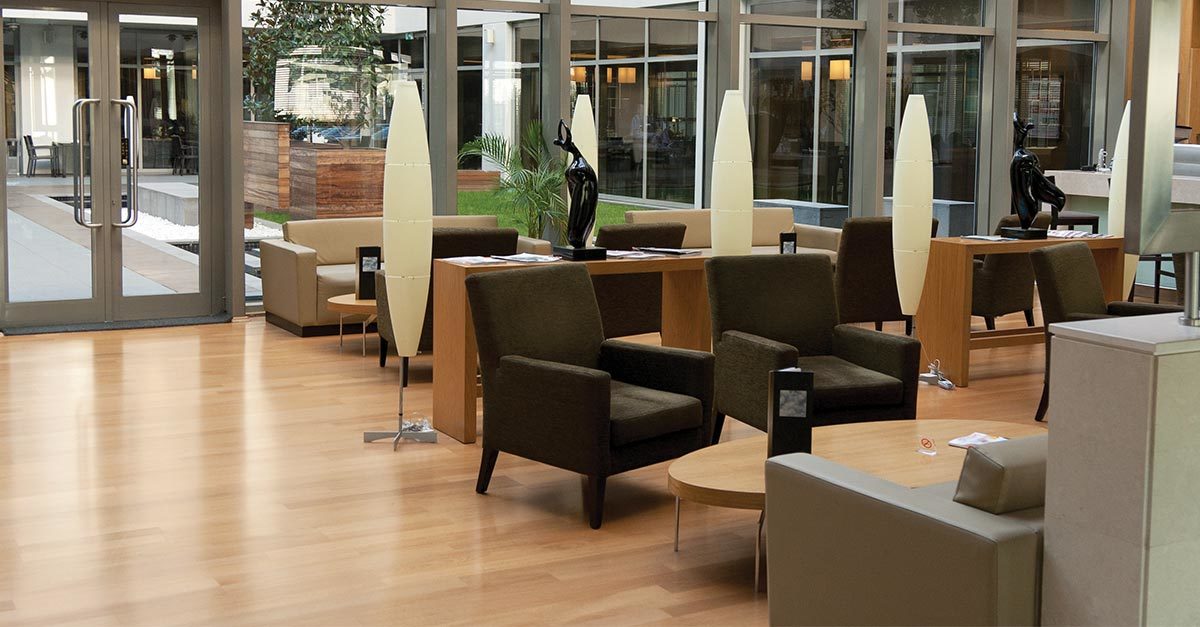Dirty, worn flooring sends a bad message to a building’s tenants and visitors; yet keeping the floors in good shape can eat up more staff time and dollars than a facility’s budget allows. This is where the latest technology comes into play to keep a facility’s floors looking good with minimal care and expense, and often with fewer toxic products.
Easy Floor Care Need Not Be a Luxury
In CMM’s June floor care webinar, Stanley Quentin Hulin, president/CEO of Future Floor Technology, Inc., extolled the virtues of luxury vinyl tile (LVT). This flooring is available in a variety of patterns with smooth or textured surfaces and features a clear vinyl protective layer.
LVT flooring will last for years with proper care. Best of all, it does not require polishing, buffing, or burnishing. There is no need to scrub off an old protective layer and apply a new one. Although it is available in patterns that look like wood, you don’t have to strip and refinish it as you would a traditional wooden floor.
“That’s one of the benefits: You get the feel and look of wood, but you’re not dealing with wood at all,” Hulin said.
Proper LVT floor care involves no more than dry dusting it regularly, then periodically wet mopping it with a neutral cleaner. “A successful LVT program is a very simple program,” Hulin said, and it’s a cost-effective one, as well.
Multiple Layers of Protection
High-build finish systems offer promise for facility budgets as they are a long-lasting technology that will lessen the number of labor hours and finish required over an extended period of time. These systems are, in effect, made of a plastic film that can be applied in multiple layers to maximize performance, explained Mark Warner, education manager of ISSA’s Cleaning Management Institute. Up to 10 layers of this protective coating can be applied to a floor throughout several days, with time allowed for coats to dry overnight. This may seem like a lot of labor, but it saves time in the long run as floors can then go two to five years before the protective layer needs to be completely stripped and reapplied, Warner said.
These systems are ideal for high-traffic areas that are susceptible to scuffs and heel marks, such as schools. By switching to a high-built system, school custodians don’t have to completely strip the floors every year. Instead, they simply scrub and add one or two layers of finish every few months.
Warner explained school custodians typically strip a floor during the summer break and add about four coats of finish. They’ll strip one layer and add a couple more coats during the Thanksgiving, winter, and spring breaks, then repeat the entire stripping and recoating process in the summer.
“That’s about 20 coats of finish and the whole time the staff is like a dog chasing its tail trying to make a floor that doesn’t look good respond to buffing and burnishing to remove heel marks,” Warner said. While the high-build system requires about half of that labor upfront, throughout the course of two years, the facility will end up saving about four coats worth of finish and the manual hours to lay it down.
Refinishing Goes Green
Sometimes there is no avoiding floor stripping, especially in the case of worn hardwood floors. The good news is that modern products and processes make the process less toxic. Waterborne polyurethane floor finishes, Warner said, have low volatile organic compound levels, so they don’t produce the choking vapors associated with other types of solvents.
Workers can skip chemicals altogether by dry stripping floors. This process uses oscillating equipment with dry-stripping pads to remove finish through friction, Warner said. The friction turns the finish into a powder than can be simply vacuumed. However, dry stripping should never be used on asbestos tile due to the risk of releasing asbestos into the air.



